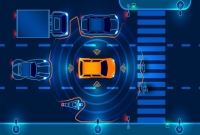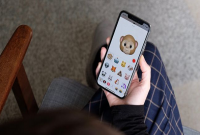
The Ultimate Guide to the Internet of Things (IoT)
- By PRIYA --
- Tuesday, 25 Feb, 2020
Raise your hand if you’ve heard of the Internet of Things (IoT).
I’m guessing most of you have your hand up.
Now, keep your hand raised if you understand how the Internet of Things (IoT) actually works.
If you’re anything like me, you’re probably scanning your brain trying to recall information from an article you read about smart homes two or three years ago … and your arm is probably getting tired. I get it. I'd lower mine, too.
The Internet of Things (IoT) was so elusive to me that I found myself thinking, I know the Internet of Things (IoT) is “here,” but what exactly is it? And how is it impacting my life?
Let’s dive into what IoT is, how it will change the future, and how you can put it to use for your business.
The Internet of Things, or IoT for short, is a network of physical internet-connected devices that can collect and share data across a network. Simply put, IoT is a term used to describe objects connected to the internet.
Your Apple Watch? That’s part of IoT. Google Home? Yup, that’s an IoT device too. Heck, the entire city of Barcelona is made up of IoT devices. Over the last few years, IoT has quietly taken the world by storm, and it isn’t slowing down anytime soon. In fact, by 2020 there will be 31 billion devices connected to the Internet of Things. To put things into perspective, that’s more than three IoT devices for every person on earth.
IoT Devices
So we have a general idea of what IoT devices are — you’re currently using one to read this article. But phones and computers only make up a small part of IoT. IoT devices include anything that can connect to the internet to send and receive data. And it turns out that almost anything can be connected this way.
There are IoT coffee machines that send out alerts when you’re running low on coffee. IoT connected beds monitor your sleep and adjust the temperature to optimize your sleep patterns. More practical applications of IoT include connected cars that can drive and update themselves and Amazon’s dash buttons that allow customers to reorder everyday products like Tide Pods or razor blades at the touch of a button. The Dash Replenishment Service takes this one step further by allowing the products to automatically reorder themselves when a sensor records that supplies are running low. When extending a market is as easy as slapping a button onto something, it’s not hard to see how companies will start to adopt this new level of connectivity.
Department stores like Macy’s are using in-store iBeacons to send customers targeted rewards and experiences like celebrity meet and greets on Black Friday. Beacons are small, Bluetooth transmitters that connect with corresponding apps installed on connected devices like iPhones or iPads. iBeacon technology allows businesses to have multi-channel communications with their customers — to reach them where they are. It also enables companies to connect with a mass audience. Before iBeacons, individual sales associates would have to tell each customer about a promotion, leaving room for error. With iBeacons, anyone who enters a store with that store’s app can receive an alert.
Let’s say you own a small business, can you still benefit from the Internet of Things? (Spoiler alert: Yes, you totally can). Actually, you may already be benefiting from it. If you use Square to accept payments, you’re using an IoT device. Since 2014, the popular credit card processing company has been connecting and sharing its data via the internet — making it easy for small businesses to receive payments.
According to Forbes, only 18% of small businesses and 13% of mid-sized companies considered IoT a priority in 2015. However, many SMBs are already reaping the benefits of the technology.
Quansett Nurseries, in Westport, Massachusetts, grows microgreens to sell to restaurants year round. Because all of the greens require different microclimates, the nursery set up sensors throughout the greenhouse so farmers could remotely control factors like humidity, temperature, and hydration. The system also automatically adjusts the climate if it senses that one of the elements is off. IoT enables Quansett Nurseries to deliver the best produce possible all year long and reduce waste.
IoT Platforms
The connected devices themselves are only half of the IoT equation though. For these connected devices to even exist, they first need to be created. And to create an IoT device, you need an IoT platform.
IoT platforms allow developers to manage the applications they build as well as store, share, and analyze data. Think about the iOS and Android platforms. Both the iOS and Android platforms allow developers to create apps faster and for less money by providing the underlying technology to solve a specific problem or need. For example, the basic technology behind optimizing connected HVAC systems to lower heating costs is the same regardless of whether a developer is using it for a small apartment or a 50-story office building. However, unlike smartphone apps, developers can choose from hundreds of IoT platforms. Amazon, Google, and IBM are a few of the major platform providers, but countless others offer different solutions for specific needs.
IoT Applications By Industry
All of these IoT devices and platforms around us accomplish a diverse range of tasks that go way beyond just reordering coffee capsules. According to Forbes, 84% of the growing IoT applications will be dominated by a few main industries: Smart Cities (26%), Industrial IoT (24%), Connected Health (20%), and Smart Homes (14%). What does that mean? Let’s find out.
Home and Security
This first category hits close to home … because it’s about your home. A few years ago, 83 million smart home devices shipped to consumers. By 2020, that number will swell to 193 million new devices per year. While seemingly every area of IoT is rapidly expanding, IoT devices within our homes are some of the most noticeable. A world where your house can talk to you and make decisions? Yeah, that’s already a thing. Connected devices currently inside homes include the usual suspects like lights you can control with your smartphone, as well as more advanced options like smart refrigerators that allow you to reorder food from built-in interfaces.
Amazon’s Alexa is currently one of the most popular and well-known smart home devices, with over 10 million new devices shipped in 2017 alone. Alexa can perform a wide variety of tasks like calling an Uber, reading you a recipe, and of course, ordering items instantly from Amazon. Affordable smart devices like Alexa, Google Home, and Apple HomePod help make IoT technology accessible to a broad audience and allow more people to become comfortable with bringing IoT into their personal spaces.
From a home security standpoint, homeowners can install IoT connected doorbells that broadcast live video to their phone when someone approaches the door or smart locks that can be pre-programmed to allow access during certain hours of the day. Say goodbye to ding-dong ditch.
Once again, Amazon is leading the way with their Amazon Key service. Using a compatible smart lock and Amazon’s cloud cam, couriers can scan the barcode on their package to unlock the door and drop it off inside your home. When the door opens, the camera starts recording and then sends a video confirming the delivery to the homeowner. It may sound creepy, but consumers have found this technology to be so useful that Amazon has already rolled it out in 37 cities.
Smart security features aren’t just good for consumers; they’re beneficial to businesses, too. By placing your products directly inside the safety of consumers’ cars or homes, businesses can avoid uncomfortable customer service calls about stolen or damaged packages, and customers get their packages on-time. It’s a win-win.






